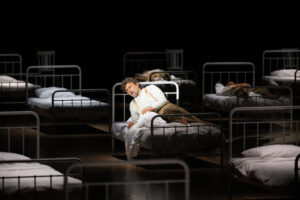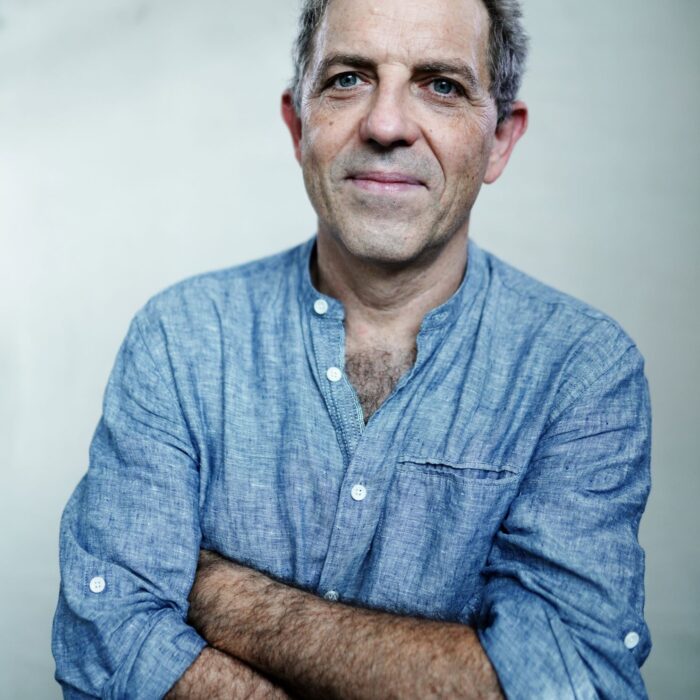
Park Avenue Armory 2023-24 Review: Doppelgänger
Jonas Kaufmann & Helmut Deutsch Shine in Claus Guth’s Unique Take on Schubert’s ‘Schwangesang’
By David Salazar(Credit: Monika Ritterhaus)
Jonas Kaufmann has been to New York over the past few years, mainly to do concert performances at Carnegie Hall.
But the last time that the tenor was in New York to do a full-blown theatrical production was five years ago when he headlined a brief stint of performances of “La Fanciulla del West” at the Met Opera. Since that fall 2018 run, New York audiences have been attentively waiting for the German superstar to return to not only give them a dose of his musical potency but his theatrical one as well.
It took the combined foresight of Pierre Audi at the Park Avenue Armory and director Claus Guth to make that a reality. And they did it in a rather unusual way.
Song & Theater
Audi gave Guth carte blanche to create a unique theatrical experience for the Armory’s massive Wade Thompson Drill Hall and the German director opted for a musical experiment – pairing Schubert’s “Schwangesang” (Swan Song) with a narrative staging. At the core of it would be Kaufmann and his frequent collaborator Helmut Deutsch. The piece would be called “Doppelganger.”
There’s no doubt that this gambit comes with a ton of built-in risks. For one, the acoustics of the hall at the Armory are not intended for a lieder recital. The space is too open and the music demands intimacy and flexibility of color from both the vocalist and pianist. Secondly, what kind of staging can you pull off with lieder when the songs themselves are disconnected narratively? And finally, how do you build momentum when each song is brief and requires a restart before the next one?
Guth’s solution to each one was adaptation and creation. Regarding the acoustics, Kaufmann was mic’d and speakers were placed around the space to adjust.
For the staging, Guth turned to the overall cycle’s themes of finality while linking the overall conception to the (originally) second song in the traditional order – “Kriegers Ahnung.” As such, the set design by Michael Levine places the action in an army hospital with nine rows of seven beds laid across the entire hall (62 beds in total because the piano replaces one of them at the center of the hall). Dancers were brought into play other wounded soldiers with Kaufmann’s character and his near-death experience at the core of the dramatization. To make it work, Guth altered the traditional order of the cycle; he also omitted “Die Taubenpost” altogether, which is actually a bit of an outsider since, unlike the other poems, written by Rellstab and Heine, this one is written by Seidl. It is replaced by “Herbst,” a song with text written by Rellstab that is often left out of the cycle (whether the “Schwangesang” is even a proper cycle has always been up for debate).
The order is as follows: “Kriegers Ahnung; “Liebesbotschaft;” “In der Ferne;” “Frühlingssehnsucht;” “Ständchen;” “Herbst;” “Aufenthalt;” “Abschied;” “Ihr Bild;” “Der Atlas;” “Das Fischermädchen;” “Am Meer;” “Die Stadt;” and “Doppelgänger.” In between the “Abschied” and “Ihr Bild” is a performance of the Andante sostenuto from Schubert’s Piano Sonata No. 21 in B-flat Major, D960. And in between all the songs, Guth teamed up with composer Mathis Nitschke to create interstitial compositions centering on drone sounds and rhythmic interjections. Moreover, some of the songs themselves don’t end in their original form but instead have their endings played on a loop (such as the ending of “Die Stadt”) or left unresolved.
An Abstract Experience
The resulting narrative is both compelling and distancing in its impact. Prior to the performance proper, as audience members enter, we hear a drone and occasion ringing. Soldiers are scattered throughout a number of beds, jumping up in fright when the bells toll. Eventually, it all goes black, and Kaufmann himself enters alongside another series of soldiers and nurses. He settles into his bed and shudders in fear. Then, with the opening notes of “Kriegers Ahnung,” he awakens. And so begins his nightmarish experience.
Each song plays like a memory or hallucination with Kaufmann’s character rushing around the stage seeking solace from someone or something. He’s a man in intense pain who knows that death is near. The first indication of this comes right before the famed “Ständchen” when in the midst of violent chaos swirling around him, he screams in terror and reveals that he is bleeding out of his abdomen. He falls to the ground and delivers the song. In other instances, he tries to escape from the other soldiers, all seemingly trying to come to terms with who he is. In other instances, he rushes toward the nurses, only to find himself rebuffed. Later on in the narrative, the soldier attempts to leave, only to be terrified by the intense light that pushes him back into the space. There is no escape for him with death so near. Since he can’t escape through one side of the hall, at the end of the work, the doors open up at the far end. It’s a potent coup de théâtre with the door of the Armory literally opening up to New York City proper. The soldier has an escape. And he takes it. But then, moments later, a silhouette enters – is it the soldier? No. Because moments later, Kaufmann returns to the theater, following this silhouette – his double – back into the space. The final number, “Der Doppelgänger” is a showstopper with Kaufmann’s soldier following his double around the space, the latter always enshrouded in shadow. We never get a good look at his face. This double makes his way back to Kaufmann’s original bed and settles into it alongside the other soldiers, all sleeping soundly. Now alone, all Kaufmann’s soldier can do is stare at how alone he is in death. And then it all goes black.
To call the narrative concrete might be a stretch, but then again, the song’s association could also be seen as tenuous at best. Nonetheless, Guth is clearly not aiming for an A to B to C narrative but more of an impression. To this effect, some pieces fare better than others. In the early going, it did feel like Kaufmann was wandering around a bit with minimal development. It didn’t mark the strongest of beginnings for the work. Things definitely get interesting right before the “Ständchen” and then ratchet up from there. But there’s also a noticeable lack of build in some instances with the frenzy of the soldiers coming early in the piece and providing an emotional high point. Once that tension is already released, no new one is truly built up for the remainder of the show. Of course, near-death experiences or war-time trauma aren’t linear and an argument can and should be made that they shouldn’t be portrayed in that manner. But while this has ebbs and flows, the contrasts are undeniably strongest in the middle of the overall experience, with the beginning slow, and the ending portion plateauing dramatically until the “Doppelgänger” arrives.
Kaufmann & Deutsch Shine
And then there’s the approach to the music, which will undoubtedly split audiences. Those who came to see Kaufmann do Schubert were unlikely to leave fully satisfied. He sang the Schubert songs, but they weren’t the pieces in their purest forms. And in terms of purity, we can’t ignore the bigger issue – the acoustic solution. Microphones, by their nature, equalize a lot, thus removing color from the voice. What thrills us about opera and live vocal recitals is the fact that we hear the purest sound out of the voice, allowing us to experience the range of colors and vibrations directly. But in this space, it was essential to use microphones because there was no way that the famed tenor would be able to make this work without straining. He made the most of it, even though on this night, he wasn’t in his best voice.
He struggled in the lower reaches, a growl often coming out of his low tenor when asked to sing softly. This was noticeable in “Die Stadt” where it took Kaufmann a bit of time to settle in. But he also struggled mightily during the opening verse of “Ständchen.” To be fair, he was lying down as he sang the opening, but he chose to sing it at a rather slow tempo and with the thread-like sound that he is so well-known for. The result was that he sounded a bit lacking in support. When he sat up, the situation improved drastically, though the softer singing remained patchy and lacked the disembodied freedom he often imbues those lines with.
But this is Kaufmann and even when not in top form, he’s a magnetic presence who has a facility with a musical line that few singers do. When he’s at his peak, the way he effortlessly delivers a line makes you really believe that there is no other way to do it. Some of those highlights would be the gentle, frightened opening of ‘Kriegers Ahnung,” the heroic potency of “Der Atlas,” or the gentle exuberance of the “Abschied” with the brightly tossed-off upper notes. Most impressive was “Doppelgänger,” each phrase growing darker and more desperate. As he followed the double around the stage, you could see and feel the existential dread, the realization of finally losing to death. It was gripping beyond belief.
And yet, for all of Kaufmann’s brilliance, it was Deutsch who might have stolen the show. Not only was he a major figure throughout the songs and the interstitial passages, but the atmosphere was charged the moment the theater went black and a single spotlight shone over him for the start of the Schubert Sonata. This is a piece of devastating beauty and built on an ascending melody, disrupted by a thirty-second note and eighth-note figure in the base. Eventually, as the melody closes in on its increasingly agitated climax, a higher eighth note separates itself from the pack. Tenderness returns, but the piece constantly returns to these agitated figures. In Deutsch’s hands, it felt like the music was desperately trying to escape from itself, particularly as the piece turned toward its stormier middle passage. Eventually, he calmed the storm gradually, though the resounding bass notes at the end provided a perfect transition back to the pain of the theatrical piece. Throughout his playing, the soldiers all looked on, as if he were the hand of God himself speaking to them through music providing calm without overlooking the doom that faced them. It was a truly mesmerizing moment both musically, but also dramatically. It was the apex of “less is more.”
Once the show ended, it was clear that the audience of nearly 1,500 loved it. As Kaufmann, Deutsch, and the rest of the cast went from side to side of the hall to accept the applause raining down on them, I couldn’t help but think that this would have been a major success at another venue across town. Some might argue that The Met doesn’t do this kind of thing, but given the recent pivot toward more “contemporary works,” why not an attempt to expand the scope of what an operatic experience could be? If this is what it takes to get one of the world’s biggest opera stars to do a production in New York, why not? Perhaps it will happen if the current leadership pivots again toward a more flexible approach to productions and works allowed on the Met stage. Or perhaps it will take new leadership to do it.
In any case, it’s great to see the leadership at the Park Avenue Armory taking the risk and coming away with success.
Categories
News

